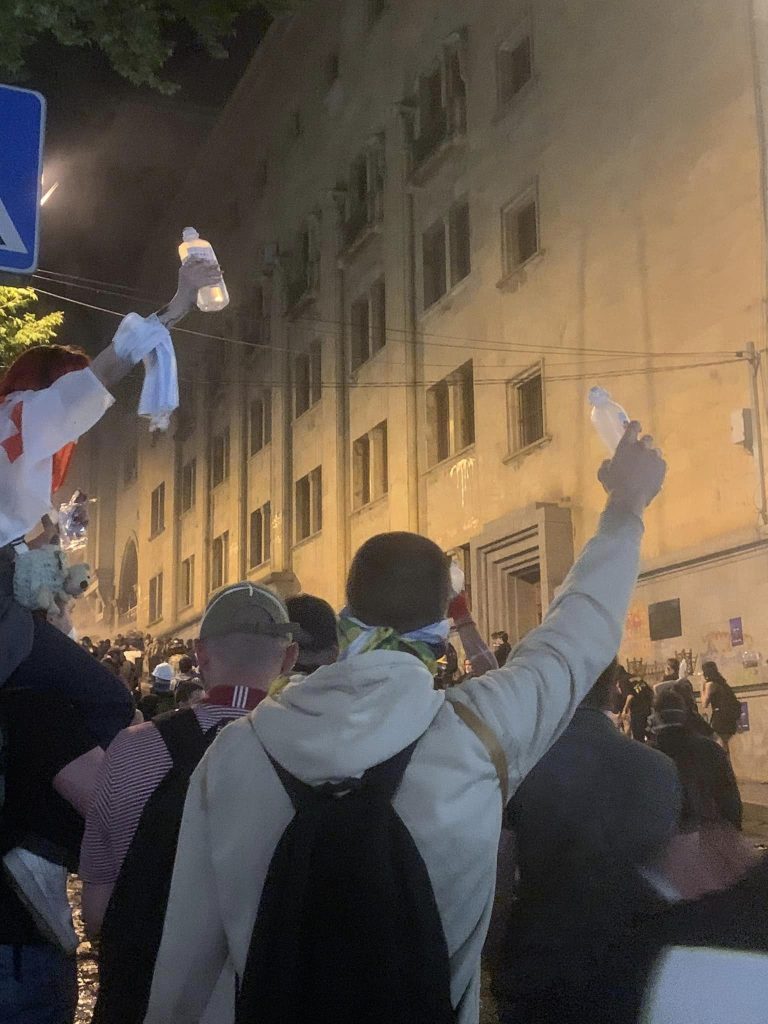In a stirring display of civic defiance, Tbilisi’s streets have become the stage for a continuous stream of protests following the Georgian government’s reintroduction of the Russian-style “agents” law. Navigating the streets of Tbilisi, one encounters a tapestry of protest actions, each with its own unique flavor. From creative displays of dissent to various forms of resistance, the protests paint a vivid picture of collective defiance.
Leaderless
What distinguishes these demonstrations is their organic, leaderless nature—a departure from conventional protest movements. Where once there were leaders guiding the masses, there is now a groundswell of grassroots activism, challenging the status quo. One finds a mosaic of organizations, movements, and individuals, all contributing to the collective outcry but without a single figurehead. This poses a challenge to the government; in its efforts to undermine the protests, it finds itself unable to pinpoint leaders. Instead, the authorities refer to the demonstrations as a collective “national movement”—a term that does nothing more than ironically amuse protesters.
Generational dynamics also play a significant role in shaping the protests. While participants span different age groups, it’s the energy and enthusiasm of the younger demographic that drives the spontaneity and momentum of the movement. While millennials support rallies with their experience, knowledge sharing and logistics, Generation Z infuses the rallies with vitality, energy and enthusiasm. Prime Minister Irakli Kobakhidze’s labeling of Gen Z as a “violent group” underscores the establishment’s confusion and unease with the youthful fervor.
Well-informed and equipped
While protests in Tbilisi maintain their peaceful nature, government officials persist in deploying special forces, water cannons, tear gas, and even rubber bullets against peaceful demonstrators. Attempting to arrestwhisk away MPs who voted in favor of a Russian-style foreign agent law, the special forces abuse their power. Despite their efforts, the protesters, now more organized and united than before, are standing firm against any intrusion.
Clad in masks, goggles, and spare clothes, they fearlessly confront the special forces, employing coordinated tactics. As warnings of raids blare, water cannons and tear gas are unleashed. Despite the high risk of panic and injury, tens of thousands of protesters support each other, remaining composed and steadfast. They briefly retreat to catch their breath, regroup, and swiftly return to their positions. Despite the relentless pressure, the special forces find themselves unable to break up the gathering.

Empowered by awareness, equipped with necessary gear, and fueled by teamwork, the protesters stand ready for a prolonged struggle. Speaking at a rally organized by the Georgian Dream, its leader, oligarch Bidzina Ivanishvili, confidently predicted that fatigue will eventually wear down the protesters, leaving them exhausted for the elections. However, the resilient citizens on the streets of Tbilisi are embracing the challenge, proving themselves unyielding, while it’s the police who are showing signs of fatigue.
Unity and solidarity
After the dispersal of tear gas, you’ll notice several young people rushing towards you, armed with saline solutions and water, eager to provide quick and selfless help. Standing in the middle of the crowd nowadays feels like being embraced by one large, supportive family, always ready to lend a hand unconditionally. Within this gathering, there are no strangers—everyone is connected, ensuring that you’re never alone. The atmosphere is filled with strong unity and friendship, showing the unprecedented togetherness among Georgian citizens.
Each person is committed to contributing to the cause: some organize food supplies, others arrange transportation, and some provide necessary equipment. This collective enthusiasm and unity represent a remarkable part of these protests, filling participants with hope and a strong belief in achieving victory.
Volunteers mobilize through social networks, forming many groups united by one goal: helping their fellow protesters. Before the wave of protests hit Tbilisi, a Facebook group called “Host” emerged, offering housing, transportation, and other basics to individuals from the regions eager to join. Within hours, the group’s membership soared to 100,000, showing the deep sense of unity. Additionally, a solidarity fund was set up, with citizens—both local and immigrants—contributing funds for transportation, equipment, and support for fellow demonstrators.
This grassroots mobilization and sharing of resources underlines the genuine, unbreakable spirit of the protests—a quality that authorities find most difficult to deal with.
What’s the plan?
No one knows.
The uniqueness of this protest lies in its spontaneity. While Tbilisi’s Rustaveli Avenue remains the traditional gathering place, the strategy of marching and occupying various facilities and streets in Tbilisi leaves the government uncertain. Without premeditated plans, the strategy of quelling the protests proves ineffective.
Participants’ primary objective is to generate noise, occupy city streets, and amplify their message to as many people as possible. As this process unfolds, ideas of blocking strategic points in Georgia, paralyzing cities, and unsettling the population gradually come to light. “Everyone should be worried,” “The regime should feel fatigued,” and “The police should be overwhelmed” are common thoughts among participants nowadays.
Decisions on how, where, and when to act are made on the spot, forcing the government into spontaneous reorganization, consuming significant time and resources. Amidst the uncertainty, one certain plan stands out: to ensure the protestors’ voices are heard by all.